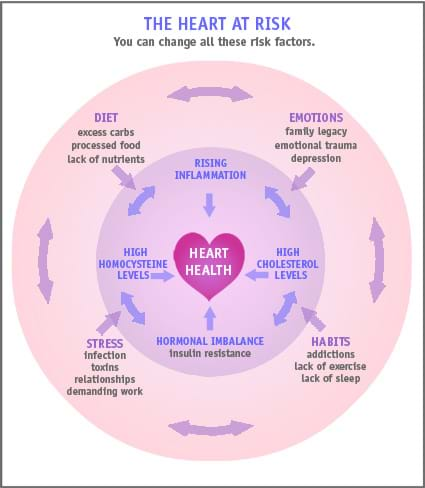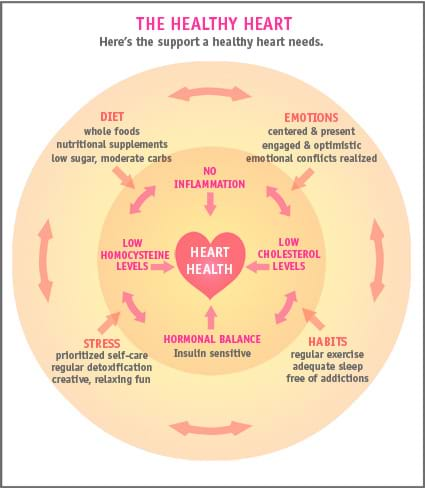There are many different problems of the heart and circulatory system. They are often interrelated, but each has its own name. Here’s a list of the key conditions and what they mean.

Angina. Pain felt in the chest due to insufficient blood supply to the heart, generally as the result of arteriosclerosis of the coronary arteries, usually experienced during exercise or stress.
Arrhythmia. A disruption of the regular rhythmic beating of the heart. Arrhythmia can occur in a healthy heart and be of minimal consequence. It also may indicate a serious problem and lead to heart disease, stroke or sudden cardiac death.
Atherosclerosis. A process in which the blood vessels narrow and harden through build-up of plaque in the walls of arteries. Plaque is made up of deposits of fats, cholesterol and other substances. Plaque formations can reduce or close off the blood’s flow through an artery. When a plaque formation becomes inflamed and unstable, it may rupture, setting loose a blood clot that can narrow the artery or completely block it. When that blockage occurs in a coronary artery (the arteries that supply blood and oxygen to the heart itself), it can cause a heart attack. When it occurs in a carotid artery (the main arteries in the neck that supply blood to the brain), it can cause a stroke. If the blockage remains in the peripheral arteries, it can cause pain, changes in skin color, sores or ulcers, or difficulty walking. Total loss of circulation to the legs and feet can cause gangrene and loss of a limb.
Cardiomyopathy. A disease in which the heart muscle becomes inflamed and doesn’t work as well as it should. There may be multiple causes, including viral infection. Primary cardiomyopathy cannot be attributed to a specific cause, such as high blood pressure, heart valve disease, artery diseases, or congenital heart defects. Secondary cardiomyopathy is due to specific causes. It is often associated with diseases involving other organs as well as the heart. There are three main types of cardiomyopathy: dilated; hypertrophic; and restrictive.
Congestive heart failure. Develops when the heart’s pumping ability diminishes due to blockages or restriction of blood flow. With heart failure, the weakened heart can’t supply the cells with enough blood. This results in fatigue and shortness of breath. Everyday activities such as walking, climbing stairs, or carrying groceries can become very difficult.
Coronary artery disease (CAD). CAD refers to atherosclerosis in the coronary arteries, which supply the heart muscle with blood.
Carotid artery disease. Atherosclerosis in the arteries that supply blood to the brain.
Endocarditis. Infection of the heart’s inner lining (endocardium) and valves. Bacterial endocarditis occurs when bacteria in the bloodstream (bacteremia) lodge on abnormal heart valves or other damaged heart tissue. This can occur during dental and periodontal surgical procedures.
Heart attack (coronary thrombosis, myocardial infarction [MI]). When the heart muscle, or myocardium, stops functioning due to loss of blood flow, nutrients, or electric signal.
High blood pressure/hypertension. Your heart pumps blood in a loop through the body: out through the arteries, back through the veins. Blood pressure is the force in the arteries when the heart beats (systolic pressure) and when the heart is at rest (diastolic pressure) measured in millimeters of mercury (mm Hg). Blood pressure is driven in large part by the openness and elasticity of the blood vessels, which can be negatively affected by atherosclerosis, hormonal imbalance, and nerve signals from the brain. Besides being a measure of poor cardiovascular health, high blood pressure forces your heart and arteries to work harder, and your major organs are affected. You can live for a long time with no signs of high blood pressure, until the whole system begins to collapse under the workload. High blood pressure directly increases the risk of coronary heart disease (which leads to heart attack), stroke, heart failure and kidney failure, especially when combined with other risk factors. We highly recommend the book What Your Doctor May Not Tell You About Hypertension, by Mark Houston, MD.
Hypercholesterolemia/hyperlipidemia are the terms used to describe chronic high levels of cholesterol in the blood, largely exacerbated by diet. Small fat deposits beneath the skin can signal hypercholesterolemia. Familial hypercholesterolemia is a rare genetically inherited disorder that causes severe high cholesterol beginning at birth and is unrelated to diet.
Mitral valve prolapse. The mitral valvel lies between the heart’s left atrium (upper, holding chamber) and left ventricle (lower, pumping chamber). The mitral valve has two flaps, or cusps. Mitral valve prolapse is when one or both valve flaps are enlarged, and some of their supporting “strings” may be too long. As a result, when the heart beats the mitral valve flaps don’t close smoothly or evenly. Instead, part of one or both flaps collapses. This sometimes lets a small amount of blood leak backward through the valve and may cause a heart murmur. Mitral valve prolapse is also known as click-murmur syndrome, Barlow’s syndrome, balloon mitral valve, and floppy valve syndrome.
Peripheral artery disease (PAD). Peripheral artery disease (PAD) occurs when arteries outside the heart and brain become blocked. The most common cause of PAD is atherosclerosis, a hardening and narrowing of the arteries due to fatty buildups. PAD is most common in the arteries in the pelvis and legs.
Stroke. Affects the arteries leading to and within the brain. Strokes occur when blood vessels that carry oxygen and nutrients to the brain are either blocked by a clot (thrombosis or embolism) or burst. When that happens, part of the brain can’t get the blood (and oxygen) it needs, so it starts to die. Most strokes are caused by thrombosis or embolism; these are called ischemic strokes. Ruptured blood vessels cause hemorrhagic or bleeding strokes.










